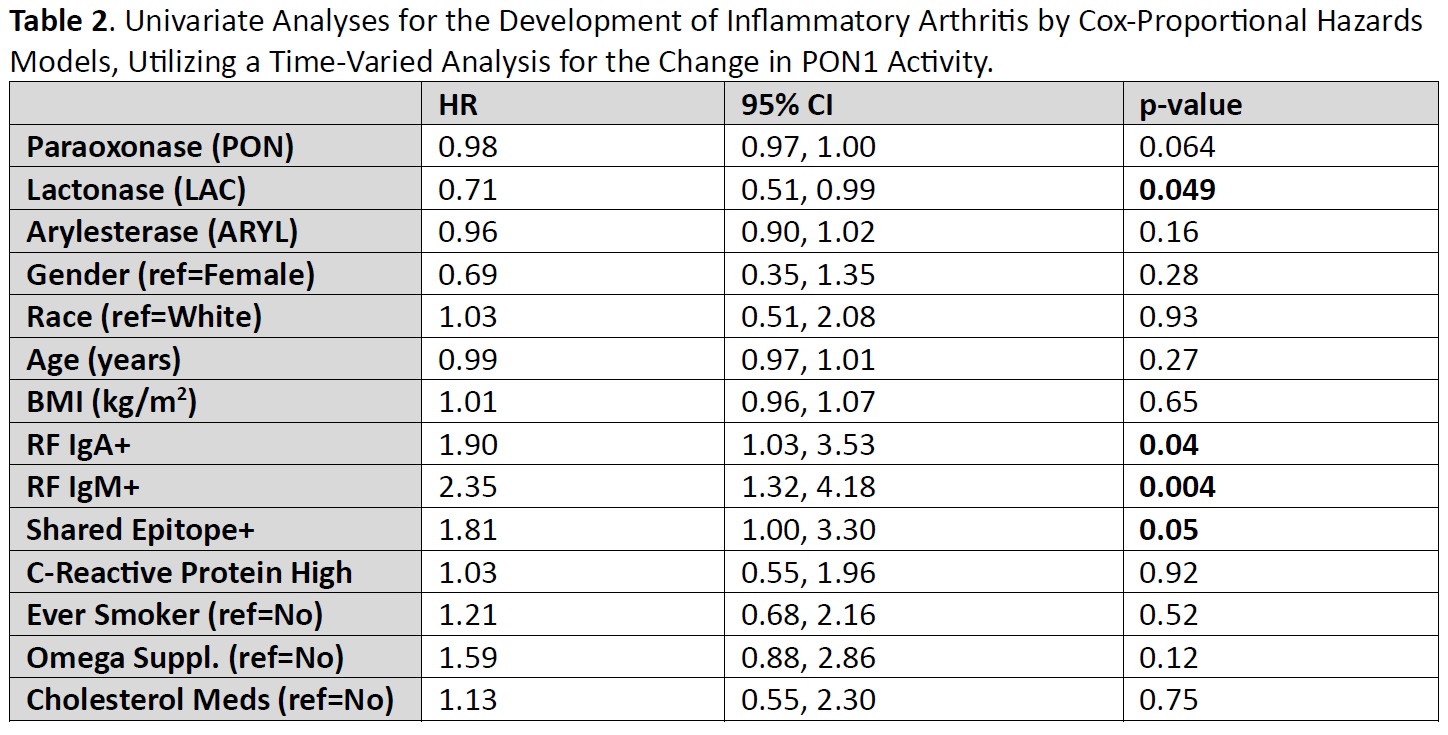Session Information
Session Type: Poster Session A
Session Time: 10:30AM-12:30PM
Background/Purpose: Rheumatoid arthritis (RA) has a well described pre-clinical state, with a continuum of genetic and environmental risk factors leading to the development of systemic autoimmunity, and ultimately inflammatory arthritis (IA) to classifiable RA (Deane KD, et al. Arthritis Rheumatol, 2022). While there are some known risk factors for the transition of individuals who are at-risk for RA (termed ARI) to IA, there are still many unknown variables. Paraoxonase-1 (PON1) is an HDL-associated enzyme which metabolizes pro-inflammatory oxidized lipids, associates with decreased cardiovascular risk, and reduced inflammatory arthritis activity and damage in the K/BxN mouse model of RA (Charles-Schoeman C, et al. Sci Rep, 2020). The current study aimed to investigate the role of PON1 in the development of IA in an anti-citrullinated protein antibody (ACPA)-positive ARI population.
Methods: The ACPA(+) ARI group included prospective evaluations of a Colorado-based cohort of individuals who did not have IA at baseline; A subset (n=49 [37%]) developed IA (termed ‘Converters’) and the remaining participants (n=84 [63%]) did not develop IA (termed ‘Non-converters’). Samples were available from baseline, longitudinally every 6-12 months, as well as at or after the development of IA for Converters. PON1 activity was measured by 3 domains of enzymatic activity: i) paraoxonase (PON), ii) lactonase (LAC), iii) arylesterase (ARYL) as previously described (Charles-Schoeman C, et al. Sci Rep, 2020). Cox-proportional hazards models were used with changes in PON1 activities included as time varying variables to determine if PON1 activity over time associated with IA development. Variables were selected for inclusion in multivariable analysis if they were associated with IA development in univariate models (p≤ 0.05).
Results: Baseline characteristics of the Converters and Nonconverters are presented in Table 1. Notably, Converters had a higher prevalence of shared epitope (SE) positivity. Also, PON activity, which is strongly associated with the PON1Q192R polymorphism was higher in Converters, although LAC and ARYL activities were not different at baseline between groups (Table 1). In univariate Cox-proportional hazards models (Table 2), increases in LAC over time associated with reduced risk for development of IA, while SE, RF IgA+, and RF IgM+ associated with increased risk of IA. In multivariate analysis including SE and RF IgA+, the lactonase activity of PON1 remained significantly negatively correlated with the development of IA (HR =0.69 [95% CI 0.49, 0.98, p=0.04]) (Table 3).
Conclusion: The lactonase activity of PON1 associated with reduced risk of IA development in ACPA(+) ARI. The higher paraoxonase activity noted in Converters at baseline will be further explored by genotyping for the PON1Q192R polymorphism which may be contributing to this difference. Further study is warranted to validate these findings and understand the underlying biologic mechanisms.
p-value by Student’s t-test for continuous variables, and Chi-squared testing for categorical variables.
RF IgA+, RF IgM+, Shared Epitope+, and C-Reactive Protein Elevated are categorical, yes/no.
IA: Inflammatory arthritis; BMI: Body mass index; RF: Rheumatoid factor.
RF: Rheumatoid factor.
To cite this abstract in AMA style:
Razmjou A, Guo R, Elashoff D, Deane K, Norris J, Feser M, Wang J, Shahbazian A, Charles-Schoeman c. Increases in Paraoxonase-1 Activity over Time Associates with Reduced Risk of Incident Inflammatory Arthritis in an Anti-Citrullinated Protein Antibody-Positive Population [abstract]. Arthritis Rheumatol. 2024; 76 (suppl 9). https://acrabstracts.org/abstract/increases-in-paraoxonase-1-activity-over-time-associates-with-reduced-risk-of-incident-inflammatory-arthritis-in-an-anti-citrullinated-protein-antibody-positive-population/. Accessed .« Back to ACR Convergence 2024
ACR Meeting Abstracts - https://acrabstracts.org/abstract/increases-in-paraoxonase-1-activity-over-time-associates-with-reduced-risk-of-incident-inflammatory-arthritis-in-an-anti-citrullinated-protein-antibody-positive-population/



